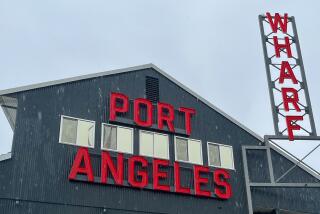Civic Success Story : How Seattle Grew Up to Its Scenery
- Share via
SEATTLE — For the longest time, no one paid much attention to Seattle. Tucked away in the Pacific Northwest, it was as quaint and unobtrusive as it was wet, a big little city in the Great Beyond that New Yorkers didn’t even count in their definition of “The Coast.”
The British conductor Sir Thomas Beecham visited Seattle in the ‘60s and called it an “aesthetic dustbin.” The New York humorist Fran Lebowitz dismissed it as cute, and when Boeing, the city’s largest employer, hit the skids in the ‘70s, the Japanese sent care packages.
Today, however, a new city towers over the frontier town built by lumbermen and fishermen. Seattle not only has become the hub of a booming Pacific Northwest, it is now to the West what San Francisco was in the ‘60s and Denver was in the ‘70s--the hot, “in” city for young professionals in search of Eden.
Picture-Postcard City
Below the 76-story Columbia Center--tallest building on the West Coast--the city Harper’s magazine in 1974 acclaimed as the most livable in the United States unfolds like an alpine postcard. The hills downtown are so steep that members of the Seattle Symphony once hauled their cellos and tubas by pulley from the parking lot to the practice hall. Wherever you turn, there are mountains disappearing into clouds, streets that seem to tumble into lakes and bays, wooded peaks kept green by the constant drizzle of gray winter days.
In the shadow of Queen Anne Hill sits the new, $90-million convention center, built over 12 freeway lanes of Interstate 5. Pioneer Square and the Pike Place Market have been saved from demolition and restored. Abandoned railroad rights-of-way have been turned into bike paths. A 1.3-mile bus tunnel and underground terminal is near completion and 11 of the downtown buildings rise to 40 stories or higher. The Kingdome, resembling a concrete orange juicer near the shores of Elliot Bay, is home to two professional sports teams. Not far away is Elliot Bay Book Company, where browsers can eat quiche and hear readings by noted authors from throughout the country.
Non-political Beginnings
What is perhaps most remarkable about Seattle’s 20-year transformation--product of the largest per-capita public improvement project ever undertaken in the United States--is that the impetus came not from politicians but from the people. Leading the citizenry was one man, an attorney named James Ellis, who decided more than 40 years ago that he would dedicate his life to doing something worthwhile in the name of his younger brother, Bob, a soldier killed in World War II.
Ellis is a small, animated man who percolates with energy. He leans back in his chair and hoots in triumph as he recounts how corporate executives, newspaper editors and political leaders, one by one, came aboard the movement known as Forward Thrust. He hunches forward, tapping the desk with a finger, as he tells how he and his wife, Mary Lou, spent night after night ringing doorbells in the neighborhoods, working to drum up support for the bond financing necessary to underwrite Seattle’s rebirth.
Back in 1958, before there was an Environmental Protection Agency, Ellis helped to form an agency known as Metro to clean up polluted Lake Washington. Then, in 1965, he announced the outlines of Forward Thrust at a Rotary Club luncheon--having failed to tell the mayor, seated next to him, what he was about to say.
“I knew the politicians would be mad, but I had no idea how mad,” he recalled. Eventually, from 2,000 ideas submitted, 13 proposed projects were selected and put to a special election in February, 1968. The voters approved seven of them, thus taxing themselves $340 million. (Seattle is now paying off the 40-year bonds, issued at a 4.65% interest rate, at 15 cents on the dollar because of inflation, Ellis said.)
The clouds drifted by Ellis’ office window on the 54th floor, obscuring the view of the city. “I think,” he said, “that you can’t have a really good city if people don’t care. Of course, you get good and bad from citizens, and we didn’t always guess right, but when you have citizens who are willing to get involved some amazing things can happen.”
Port, Lumber Booms
While some Western cities such as Denver and Houston were stumbling into depressed times everything seems to have fallen into place for Seattle. Its port--the closest major U.S. mainland harbor to Alaska and the Orient--has capitalized on expanding trade links with the Pacific Rim. Boeing in 1988 enjoyed a fourth consecutive year of record sales, and its Seattle work force, down to 37,500 in the early ‘70s, now numbers 96,000. The lumber industry has recovered and the local economy has been revived and diversified as more and more technology industries have found the Northwest an attractive place to call home.
On top of that, the 1962 World’s Fair was a money-maker. It left Seattle with a fine opera house, playhouses, art museums and a science center. Seattle spends more on the arts per resident than any other U. S. city--by ordinance, 1% of the budget for all public capital projects must go to the arts. More people work in the theater here than anywhere else outside New York and San Francisco. A growing community of writers now lives around Puget Sound, too. Among the attractions they mention is that Seattle is neither pretentious nor self-conscious.
“Work counts quite a lot here, and the scenery and weather give you a sort of blanket of privacy,” said novelist Ivan Doig, who moved to Seattle in 1966 from the Chicago area because he hungered for trees and mountains and water vistas. “The rewards of work are great enough that writers don’t spend much time putting themselves on display. There is a certain lack of flashing the colors of our feathers at each other, as you might find in Los Angeles or New York.”
But many people, Doig among them, are concerned that Seattle’s sudden popularity and growth are bringing unwanted changes. The city, shaped like an hour-glass wedged between Puget Sound and Lake Washington, already has spilled over into the last of the remaining river valleys, the Snoqualmie.
Traffic, Gangs and Smog
Downtown traffic congestion is the sixth worst in the nation, according to one survey. Two street gangs, the Bloods and the Crips, have found their way here from Los Angeles and brought with them drive-by shootings. There are touches of pollution in the air--and 50,000 new arrivals a year in the Seattle metropolitan area (population 1.8 million).
On Madison Street, the Rev. Samuel McKinney watches with distress as gentrification pushes up the hill toward Mt. Zion Baptist Church from two directions, westward from Lake Washington and eastward from Puget Sound. He is pleased with the new economic vigor but not convinced that blacks are sharing in the prosperity.
“The yuppies are buying up everything,” he said. “I tell the members of my congregation, ‘Don’t sell your property. It doesn’t make sense for you to sell for $60,000, then have to move somewhere else and take out a $100,000 mortgage. You are carrying a heavy burden, as it is.’ ”
In the window of a second-floor office overlooking the Pike Place Market, a small neon sign reads “Lesser Seattle.” It was a present to Emmett Watson on his 70th birthday. The venerable columnist of the Seattle Times believes all great revolutionary movements start in bars, and his was no exception.
A Cafe Revolution
Lesser Seattle--the antithesis of Ellis’ Forward Thrust--was born at the bar of the 610 Restaurant on the corner of 6th and Pine streets. Watson and some cronies decided the city was just right as it was; it didn’t need more people, more tourists, more industries, more development.
Over the years, Watson has written more than 100 satirical columns--suggesting that Seattle’s waiters and cab drivers be sent to New York City to learn how to be rude, advising locals to give tourists wrong directions and trumpeting the miserable climate. (He doesn’t mention that Seattle has less rainfall than Washington, D. C., and is warmer in winter than Atlanta.)
“I was just poking fun, but the effect was curious,” Watson said over espresso and a truffle in his favorite marketplace cafe. “People started taking Lesser Seattle seriously. They’d write about it, they’d talk about it. Newcomers wanted to join our ranks. Each one wanted to be the last immigrant.”
Growth, No-Growth Issue
In fact, the pace of Seattle’s growth has now become the most volatile issue here. Recently, more than 18,000 people signed a petition, circulated by the Citizens’ Alternative Plan, to set a maximum height of 35 stories for downtown buildings and slow the pell-mell dash into the ranks of major league cities. Mayor Charles Royer, a TV journalist elected 11 years ago on a platform of protecting the neighborhoods, got the message. “Residents are telling us that too much is happening too fast,” he said.
Seattle was first settled in 1851 by five families from Illinois. They called their little community on Elliot Bay “New York-Alki,” Indian for “New York by-and-by.” Before coming here, they had camped in what is now Portland, Ore. One of the pioneers, Arthur Denny, sent his younger brother, David, north to scout the Puget Sound region. David wrote back: “We have examined the valley of the Duwamish River and find it a fine country. There is plenty of room for a thousand settlers. Come at once.”
Arthur Denny’s great-grandson, Brewster Denny, a professor at the University of Washington, stood the other morning on the balcony of his condominium on 1st Street. The rain had drifted eastward and Puget Sound glistened in sunlight. The distant slopes of Mt. Rainier and the Olympic Mountains were splashed with snow. The view--and the life style--are not things Denny would sacrifice willingly.
“Don’t make the issue one of growth versus anti-growth,” he said, “because, after all, who was more responsible for the growth of this community than my family? The issue is our relationship to the land, and what kind of life you want to have in this place and whether you want to plan for the future or just let it happen.
“I worry about our caring capacity, about how many people can come here and find paradise. Which is the marginal person who will finally be one too many?”
Times researcher Nina Green contributed to this story.
More to Read
Sign up for our Book Club newsletter
Get the latest news, events and more from the Los Angeles Times Book Club, and help us get L.A. reading and talking.
You may occasionally receive promotional content from the Los Angeles Times.







